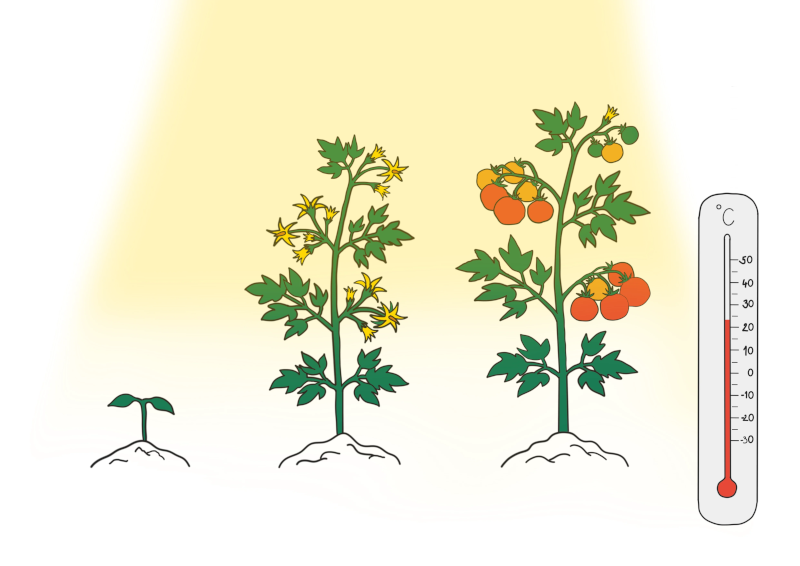The Dos and Don’ts of Plant Temperature
- by Leah Hiller
-

If you’re a plant lover like us, you know how important it is to maintain the proper temperature for your leafy friends. Temperature plays a crucial role in every stage of a plant's life, from seedling to full-grown beauty.
That’s why we created Plantee with smart sensors that constantly monitor the environment and adjust the temperature to give your plants the perfect growing conditions.
No need to worry if you haven't got a Plantee yet! Check out our list of do's and don'ts to ensure your plants have a long and healthy life.
What is the Right Temperature for Sprouting Your Seeds?
Growing plants from seeds is an exciting journey, and the right temperature is a crucial factor in their success. It can make all the difference in the world, encouraging those little seeds to sprout, promoting healthy growth, and helping your plants to thrive. On the other hand, the wrong temperature can stunt their growth or even preventing germination altogether.
Use these dos and don’ts to give your new seedlings the best possible start in life.
Do:
- Research the temperature preferences of the plant species you are growing. Typically, most seeds require temperatures between 18-24°C/65-75°F to germinate and grow well.
- Keep the temperature as stable as possible, avoiding extreme fluctuations that can harm young plants.
- If the ambient room temperature is less than ideal, use a seedling heat mat to provide the necessary warmth for healthy growth.
- Regularly water the soil to maintain consistent moisture levels, as this can help regulate the temperature and create a healthy growing environment for seedlings.
Don’t:
- Avoid using high temperatures that can damage the seeds and impact the germination process in the long run.
- Equally, don’t expose seeds to low temperatures as it can result in slow or failed germination.
- Don’t overwater the soil. Excessive moisture can lead to temperature fluctuations and create an unhealthy environment for the plants to grow.
- Avoid making drastic temperature changes as sudden changes can shock the seedlings and affect their growth.

What’s the Ideal Temperature for Strong Seedlings?
Seedlings, like babies, need a warm and nurturing environment to flourish. They're delicate and require a specific temperature range to grow strong and healthy. If it's too chilly, they may take longer to grow, or worse, not grow at all. Conversely, if it's too hot, it can cause heat stress and damage, which can hinder growth and impact the plant's overall health.
These tips will help keep your new little plants satisfied.
Do:
- Learn the ideal seedling temperature range for your particular plant species.
- Check the temperature regularly to ensure your plants are comfortable and adjust it if necessary.
- Give your plants enough space to breathe by placing them in a well-ventilated area, as they don't like to be cooped up.
- Water your plants with warm water, which helps regulate the soil temperature and keep them cozy.
Don’t:
- Avoid exposing your seedlings to excessively high temperatures, which can cause them to wilt and become stressed.
- Conversely, avoid exposing your plants to excessively low temperatures, which can stunt growth and lead to poor development.
- Don’t place your plants in drafty or cold areas, as this can negatively affect their growth.
- Avoid exposing your plants to direct sunlight or heat sources, such as radiators or heating vents, which can cause overheating and damage.
- Don’t overwater your plants. Overwatering can cause waterlogging and negatively affect the soil temperature.
Don’t Forget to Give Your Mature Plants Some TLC, Too
Like seedlings and young plants, mature plants also require specific temperature conditions to promote optimal growth and health. Although mature plants are more tolerant to temperature changes, excessively high or low temperatures can still create stress and damage to the plant.
Do:
- Maintain the ideal temperature range for your plants - typically between 15-24°C/60-75°F.
- Check the temperature preferences of your specific plant species, as not all plants are the same.
- Be observant of your plants and make necessary adjustments to their environment if you notice any negative changes.
- Use shading devices like curtains or blinds to protect your plants from the direct heat of the sun.
- Use Plantee, the smart indoor greenhouse!
Don’t:
- Avoid making sudden or drastic temperature changes, as it can cause the plant to go into shock.
- Don't use untested or unproven methods for adjusting temperature, such as heating lamps or space heaters.
- Don't place plants near heating or cooling vents, radiators, or other sources of direct heat or cold.

Feeling Overwhelmed? Let the Plantee Experts Help!
Whether you're growing seedlings, young plants, or mature ones, paying attention to their temperature requirements can make all the difference in their growth and development.
If keeping track of your plant's temperature becomes a hassle, Plantee is the solution you need. It's a smart indoor greenhouse that regulates your plant's environment using revolutionary infrared technology, a temperature probe, and even "floor heating" for optimal growth.
Get a Plantee of your very own here now!




